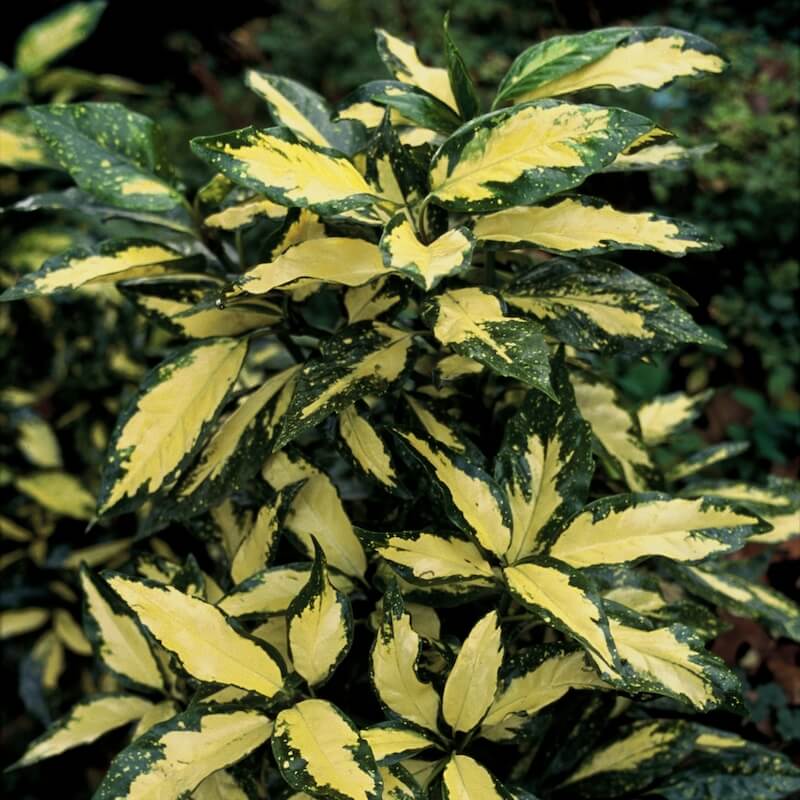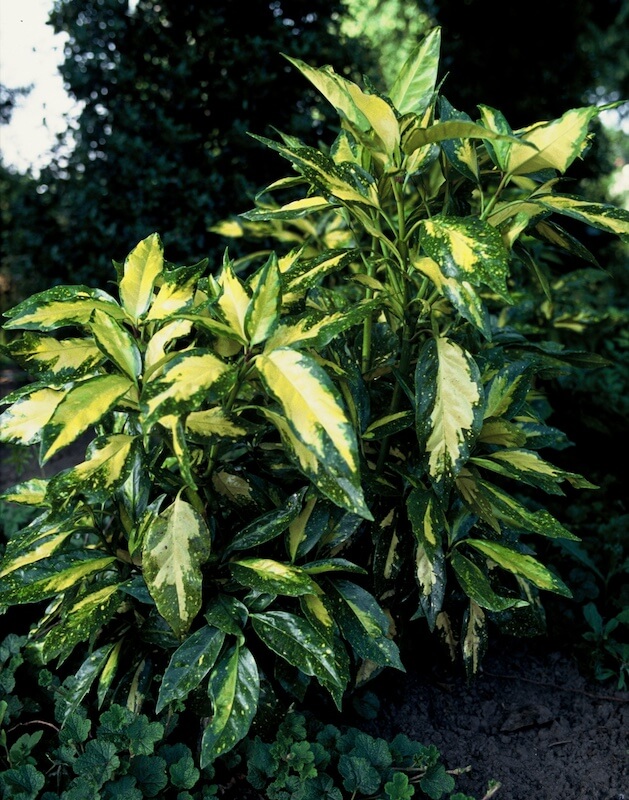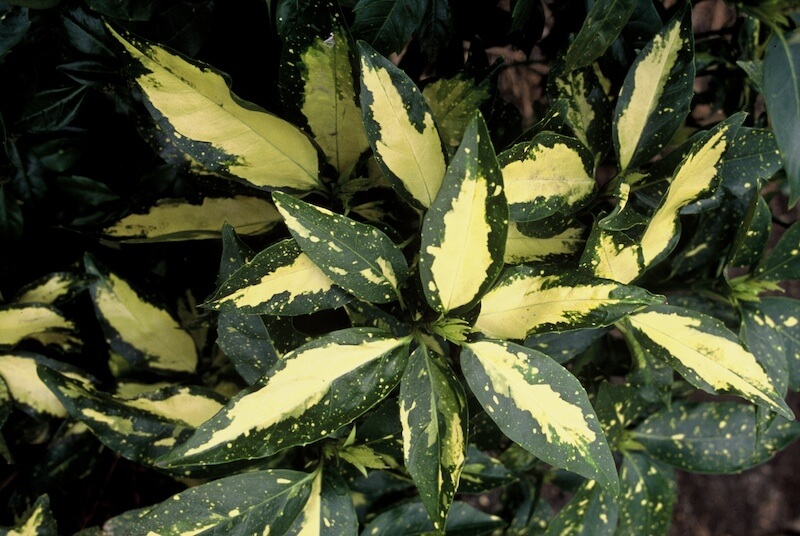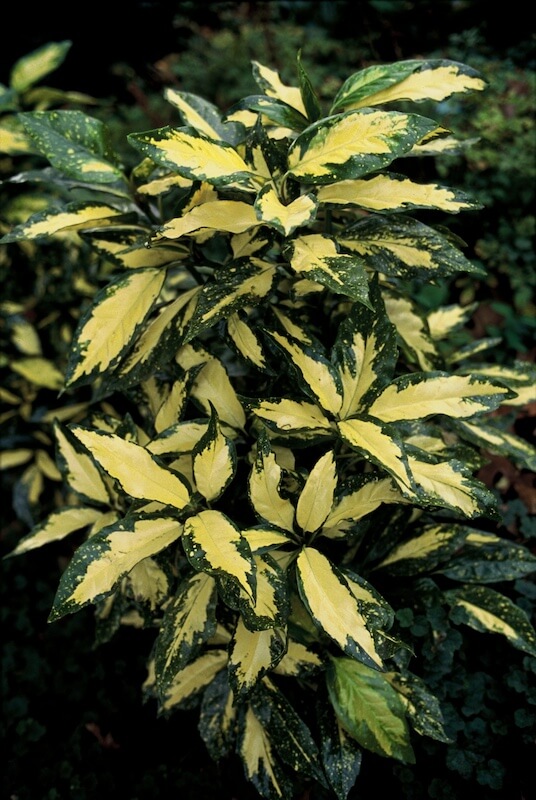
Position
- Thrives in partial to deep shade, making it perfect for north and east-facing gardens, under trees, or against fences and walls
- Tolerates full shade and is excellent for brightening gloomy or challenging areas
- Requires shelter from cold, drying winds to keep the foliage in the best condition
Hardiness
- Hardy down to around –15°C (5°F)
- Well-suited to the UK’s climate, including most winters
Soil
- Prefers fertile, moist but well-drained soil—tolerates heavy clay or sandy soils if improved with compost or well-rotted manure
- Handles urban pollution and performs in coastal areas as well
- Avoid waterlogged conditions, though it is otherwise tolerant
- Tolerates acid, neutral, or alkaline soils
- Very adaptable, provided drainage is sufficient
- Grab a soil test kit and ensure the perfect conditions for growth
Height
- Usually grows to 1.5–2.5 metres (5–8 feet) in 5–10 years
- Forms a dense, rounded, evergreen shrub with lush growth
Seasons of Interest
Additional Notes
- Prune in spring to shape and remove frost-damaged or old stems; tolerates hard pruning if rejuvenation is needed
- Mulch with compost or leaf mould in spring to nourish and retain soil moisture
- Water new plants in dry periods; established plants usually cope with drought
- Pest and disease resistant, trouble-free, and low maintenance
- Well-suited for containers, shady courtyards, and awkward spots where little else will grow
- Avoid exposed, windy sites to prevent leaf scorch
Add Bold Colour to Shady Gardens with Aucuba japonica Picturata
Looking for a vibrant, low-maintenance shrub that thrives in full shade and tolerates harsh conditions? Aucuba japonica Picturata, also known as the spotted laurel or Japanese laurel, is a colourful solution that brings cheer to even the darkest corners of your garden. This evergreen shrub offers glossy foliage splashed with golden yellow and grows beautifully in areas where other plants might falter.
What makes Aucuba japonica Picturata such a standout shrub?
Aucuba japonica Picturata is a cultivar of Japanese laurel that’s admired for its striking foliage. Each leathery, elliptical leaf is splashed with a bold, golden-yellow blotch in the centre, surrounded by dark green margins. These bright splashes almost appear to have been painted on, creating a showy display all year long.
This evergreen shrub grows tall and wide, with a bushy form that adds structure to shady borders. Its glossy green leaves reflect light and bring a luminous quality to dull spaces. This is more than just ornamental—picturata is also practical, thriving in conditions many plants avoid.
How does the spotted laurel perform in UK gardens?
Spotted laurel is well-suited to UK conditions. It grows reliably across the country, from cool coastal areas to hot summer climates in sheltered urban gardens. It tolerates pollution and shade, making it ideal for small city gardens and courtyards.
As an evergreen shrub, it offers year-round colour and structure. Its low maintenance needs and adaptability to a wide range of soils make it suitable for both beginner and seasoned gardeners. If you want a reliable shrub that’s also strikingly colourful, Aucuba japonica Picturata is an excellent addition to any garden.
What growing conditions does picturata need?
This cultivar grows best in well-drained soil that’s enriched with organic matter. It’s happy in clay, loam, or sandy soil, as long as it’s not waterlogged. Adding compost or leaf mould helps create the organically rich conditions this shrub prefers.
Plant your Aucuba japonica Picturata in full shade or partial shade. It thrives in those awkward spots—north-facing walls, beneath trees, or in the shadow of fences—where other plants often struggle. It will also tolerate some sun, especially in cooler areas, though bright golden yellow foliage can fade in intense afternoon sun.

Can Aucuba japonica Picturata grow in full sun or deep shade?
While this shrub is best known for thriving in full shade, it can also tolerate full sun if the soil stays cool and moist. However, in very bright locations, especially during hot summer climates, the bright golden yellow blotch may fade, and the leaves may scorch.
Its real strength lies in its ability to brighten deep shade. Few shrubs offer such a showy display under these conditions. From part shade to full shade, Aucuba japonica Picturata remains colourful, bushy, and resilient, making it an essential choice for shade-loving designs.
What does the flowering and fruiting cycle look like?
Small purple-red flowers appear in spring, nestled in the leaf axils. Though not large or flashy, these flowers are charming up close and are accompanied by creamy white anthers. The flowers appear in spring and are often followed by red berries on female plants, provided a male plant is nearby for pollination.
The bright red berries ripen through late summer and autumn, providing a seasonal pop of colour and visual interest. These follow the small purple flowers, making the shrub even more valuable in the garden. If you’d like to enjoy berries, be sure to plant male and female plants close together.
Is Aucuba japonica Picturata dioecious?
Yes, Aucuba japonica is a dioecious species, meaning male and female flowers grow on separate plants. To produce fruit, you need at least one male plant near your female plants. Without a male nearby, the small purple flowers on female shrubs won’t be pollinated, and no berries will develop.
For best results, group male and female plants within the same border. A single male can pollinate several female plants, so you don’t need many. This approach ensures that the flowers bloom in early spring, followed by bright red berries that ripen beautifully against the variegated foliage.
Is spotted laurel good for hedging?
Absolutely. Spotted laurel is one of the best evergreen shrubs for hedging, especially in shaded areas. Its bushy habit, dark green leaves, and showy speckles of yellow make for an attractive screen or boundary hedge.
It grows to a moderate height—usually around 1.5 to 2.5 metres—making it perfect for low to mid-level hedges. Plant each shrub 60 to 90 centimetres apart to create a dense wall of colour. Once established, the hedge provides privacy and structure while requiring minimal upkeep.

How should you prune Aucuba japonica Picturata?
Aucuba japonica Picturata requires very little pruning. Its natural form is neat and bushy, but you can shape it as needed. The best time to prune is late spring, immediately after the flowers have faded.
Remove any damaged or dead stems first. Then, prune lightly to shape the shrub or maintain a tidy hedge. Older plants can be rejuvenated by cutting back one-third of the growth to promote fresh, healthy shoots. This keeps the shrub vigorous and dense.
Can you grow Picturata Aucuba as a houseplant?
Yes, you can grow this variegated laurel as a houseplant, particularly in cool, shaded indoor spaces. It tolerates low light and is an excellent option for north-facing rooms or shaded conservatories. The glossy, green leaves with golden-yellow blotches brighten indoor corners beautifully.
Use a well-drained potting mix and place the plant in a location out of direct sunlight. Water sparingly, allowing the top layer of soil to dry between waterings. Wipe the leathery leaves regularly to keep them dust-free and shiny. As indoor plants, they grow slowly but remain attractive and easy to manage.
What are the common problems with Aucuba japonica?
This tough shrub is mostly trouble-free, but it can be affected by fungal leaf spot, especially in humid or poorly ventilated conditions. This appears as black or brown marks on the centre of the leaves and can spread if not addressed.
To avoid this issue, ensure your plant has good air circulation. Avoid overhead watering and keep the area around the base clear of debris. If fungal leaf spot appears, remove affected leaves and dispose of them in the bin rather than composting. Healthy shrubs will recover quickly once conditions improve.
From Darren’s Patch
What I appreciate about Aucuba japonica Picturata is its sheer reliability. In my garden, it’s one of the few plants that doesn’t sulk in deep shade—quite the opposite. Tucked beneath a mature tree where little else thrives, it brings an uplifting splash of gold that brightens the space throughout the year. I’ve used it to anchor shady borders, and it always holds its own, even in winter. It’s also a godsend for problem spots—dry shade, poor soil, even urban pollution. Once established, it needs very little from you but gives a lot back in terms of structure and colour. If you’re looking for a rugged yet handsome shrub that adds dependable interest to your garden, I’d wholeheartedly recommend giving ‘Picturata’ a go. It’s a real stalwart in my patch.
![]()
Key Points to Remember
- Evergreen shrub with variegated, glossy green leaves and golden yellow centres
- Grows well in full shade to part shade; ideal for north-facing borders
- Tolerates a wide range of soils, provided they’re well-drained and organically rich
- Flowers appear in spring, followed by bright red berries on female plants
- Dioecious – requires male and female plants to produce berries
- Perfect for hedging, screening, or a standalone structure
- Minimal pruning needed; prune after flowering in spring
- Can be grown as a houseplant in cool, shaded indoor areas
- Susceptible to fungal leaf spot – avoid overhead watering and improve airflow
- Low maintenance, easy to grow, and suitable for hot summer climates or urban gardens
This evergreen shrub with variegated foliage offers structure, colour, and resilience. Its ability to tolerate deep shade, poor soil, and urban conditions makes it incredibly useful. Whether you’re planting a hedge, designing a shady border, or adding colour to an indoor space, Aucuba japonica Picturata delivers dependable beauty with very little fuss.
Its golden yellow blotches, small purple flowers, and bright red berries add seasonal interest. With the right soil and a little pruning, this hardy shrub will provide years of year-round appeal in almost any garden setting.
Want to learn about other shrub varieties? Read about Aucuba japonica Crotonifolia here.
For more information on Shrubs for your garden, please click here.

Frequently Asked Questions
Q: What is Aucuba japonica Picturata, and why is it popular in UK gardens?
A: Aucuba japonica Picturata, commonly known as spotted laurel or Japanese laurel, is a striking evergreen shrub grown for its large, glossy green leaves with golden yellow centres. Valued for its year-round interest and tolerance of shade, this ornamental shrub is particularly effective as a hedge, backdrop, or low-maintenance specimen plant. Picturata is prized in the UK for its hardiness, foliage colour, and ability to brighten inhospitable corners of the garden. It’s particularly well-suited for urban, coastal, or polluted environments where other plants may struggle, and it pairs beautifully with other shade-loving shrubs or ferns.
Q: Where is the best place to plant Aucuba japonica Picturata?
A: Picturata thrives in part shade to full shade, making it ideal for the shadier areas of the garden where few other shrubs perform well. It tolerates full sun if the soil remains consistently moist, but its foliage is at its best in dappled shade. This cultivar is particularly well-suited to north- or east-facing borders, beneath deciduous trees, or in sheltered courtyard gardens. The shrub is also an excellent option for growing as a dense, evergreen hedge in shade-prone sites, providing reliable structure and colour throughout the year.
Q: What soil does Aucuba japonica Picturata prefer?
A: Aucuba japonica picturata is highly adaptable, thriving in a wide range of soils as long as they are well-drained. It performs best in organically rich soils that retain some moisture but never sit waterlogged. While tolerant of both acid and alkaline conditions, it prefers neutral to slightly acidic soil for optimal growth. Incorporating organic matter such as garden compost or leaf mould can be a valuable improvement to enhance soil structure and water retention. It is remarkably resilient even in urban soils, making it a go-to choice for low-maintenance planting schemes.
Q: How should I feed and care for Aucuba japonica Picturata?
A: This shrub is low maintenance, but it benefits from a spring feed using a balanced, slow-release fertiliser or organic mulch. Apply compost or well-rotted manure around the base in early spring to support healthy growth and improved moisture retention. Water well during dry spells in the first season, but established plants are drought-tolerant. Prune lightly after flowering to shape and remove any damaged or unsightly stems. Regular care helps encourage fresh, showy foliage and improves air circulation. Avoid excessive pruning, as this can limit berry production in female plants.
Q: When does Aucuba japonica Picturata flower, and what do the flowers look like?
A: Small purple-red flowers appear in spring, typically from March to May, nestled in the leaf axils. Bright red berries on female plants follow these if a male aucuba is nearby for pollination. While the flowers are not especially showy, they provide seasonal charm and help support pollinators in early spring. The real ornamental appeal lies in the dramatic, variegated foliage — glossy dark green leaves marked with bold golden yellow blotches that remain attractive throughout the year.
Q: Does Aucuba japonica Picturata produce berries?
A: Yes, female plants of Aucuba japonica Picturata produce clusters of bright red berries in late summer through winter, adding valuable seasonal interest. However, berry production requires a male Aucuba nearby for pollination.. These berries are not edible but are attractive to birds and add further visual appeal, particularly when set against the glossy, variegated foliage. If you want berries, please make sure that you include at least one male plant in your garden.
Q: Can Aucuba japonica Picturata be grown as a hedge?
A: Absolutely. Picturata makes an excellent evergreen hedge for shady areas, with its dense, bushy growth habit and colourful foliage providing a vibrant boundary or privacy screen. It’s well-suited for informal or semi-formal hedging and can reach a height of 1.5 to 2 metres with a similar spread if left unpruned. Trim lightly in spring or after flowering to maintain its shape and structure. Its tolerance of pollution, salt-laden air, and dry shade makes it a highly effective hedge in both rural and urban settings.
Q: Is Aucuba japonica Picturata suitable for coastal gardens?
A: Yes, Aucuba japonica Picturata is well suited to coastal gardens thanks to its tolerance of salt-laden air and drying winds. It also thrives in dry shade and performs well in poor, sandy soils, as long as drainage is sufficient. This hardiness makes it a versatile option for exposed sites near the coast, where many other evergreen shrubs may fail. Whether used as a specimen shrub or in mixed borders, it remains an attractive, resilient feature throughout the year.
Q: Can Picturata be grown indoors or in containers?
A: While Picturata is typically grown outdoors, it can be grown in large containers or used as an indoor plant in cooler, well-lit rooms. When grown in pots, use a loam-based compost with added grit for drainage, and feed the plants monthly during the growing season. Container-grown plants benefit from occasional repotting and must be kept moist but never soggy. Indoors, ensure the plant is kept out of direct hot sun and away from drying heat sources to avoid leaf scorch or wilting.
Q: Where can I buy Aucuba japonica Picturata?
A: Aucuba japonica Picturata is widely available at reputable garden centres and nurseries across the UK. It can also be purchased online from specialist shrub suppliers and mail-order plant retailers. When purchasing, select healthy, well-established plants, ideally with strong, bushy growth and vibrant foliage. Online sources often offer a broader range of cultivars and sizes, including both male and female plants for berry production. Always check the supplier’s plant quality and delivery reviews for the best results.
